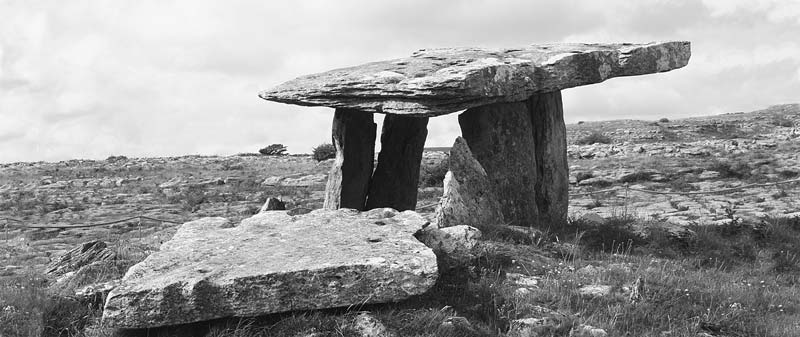
Ennis • Cliffs of Moher • Doolin • Lisdoonvarna • The Burren • Ballyvaughan • Kinvarra
Map: County Clare & the Burren
Orientation to the Cliffs of Moher
Those connecting Dingle in the south with Galway up the coast to the north can entertain themselves along the way by joyriding through the fascinating landscape and tidy villages of County Clare. Ennis, the county’s major city, is a workaday Irish place with a medieval history and a market bustle—ideal for anyone tired of the tourist crowds. Overlooking the Atlantic, the dramatic Cliffs of Moher offer tenderfeet a thrilling hike. The Burren is a unique, windblown limestone moonscape that hides an abundance of flora, fauna, caves, and history. For your evening entertainment, you can join a tour-bus group in a castle for a medieval banquet in Kinvarra or meet up with traditional Irish music enthusiasts from around Europe for tin-whistling in Doolin.
A car is the best way to experience County Clare and the Burren. The region can be an enjoyable daylong drive-through or a destination in itself. None of the sights has to take much time. But do get out and walk a bit.
If you’re driving from Dingle to Galway, I’d recommend the following day plan. Rather than the main road via Limerick, drive north from Tralee via Listowel to catch the Tarbert-Killimer car ferry (avoiding Limerick traffic and the 80-mile/1.5-hour end-run drive around the Shannon estuary; see “Route Tips for Drivers” at the end of the previous chapter). From Killimer, drive north on N-67 via Kilkee and Milltown Malbay. The little surfer-and-golfer village of Lahinch makes a good lunch stop. Then drive the coastal route to the Cliffs of Moher for an hour break. The scenic drive from the cliffs through the Burren, with a couple of stops, takes about two hours. Consider partaking in the 17:30 medieval banquet at Dunguaire Castle, near Kinvarra (just 30 minutes south of Galway).
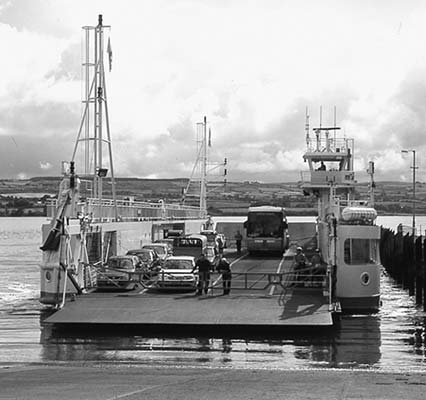
By train or bus, your gateways to this region are Ennis from the south and Galway from the north. In 2010, a new rail line was finished, connecting Limerick (via Ennis) and Galway for the first time in decades—a big plus for those staying in Ennis and relying on public transport. But linking the smaller sights within County Clare and the Burren by bus is still difficult: Book a tour instead (see “Tours in the Burren,” next page).
Tips: Visit an ATM in Ennis, Galway, or Lahinch before you enter this region (there are no ATMs in Doolin, Lisdoonvarna, Kilfenora, or Ballyvaughan). Skip the Bunratty Castle and Folk Park—I’d leave this most commercial and least lively of all European open-air folk museums to the jet-lagged, big-bus American tour groups (it’s located just a potty stop from the Shannon Airport, past Limerick on the road to Ennis).
Most travelers zip through the seemingly barren Burren without stopping, grateful for the soft soil they garden back home. But healthy hikers and armchair naturalists may want to slow down and take a closer look. Be sure to wear comfortable shoes for the wet, uneven, rocky bedrock. These local guides can bring the harsh landscape to life.
From Ballyvaughan (at the northern entrance to the Burren): Shane Connolly leads in-depth, three-hour guided walking tours, explaining the region’s history, geology, and diverse flora, and the role humans have played in shaping this landscape. This proud farmer really knows his stuff (€15, daily at 10:00 and 15:00, call to book and confirm meeting place in Ballyvaughan, tel. 065/707-7168, http://homepage.eircom.net/~burrenhillwalks).

From Kilfenora (at the southern entrance to the Burren): Tony Kirby leads regularly scheduled two-hour “Heart of Burren Walks” during the summer, and the rest of the year by appointment. His expertise peels back the rocky surface to reveal the surprisingly fascinating natural and human history that has created this unique region (€20, June-Aug Tue-Thu at 14:30, Fri-Sun at 10:30, meet at the Burren Centre in Kilfenora, tel. 065/682-7707, mobile 087-292-5487, www.heartofburrenwalks.com, info@heartofburrenwalks.com).
From Galway: The Burren Wild Tour departs from Galway and combines an interactive walking tour of the Burren with a visit to the Cliffs of Moher. Their motto, “Don’t be nuts, get off the bus,” distinguishes their active hiking focus from other, more sedate tour outfits (€25, buy ticket from TI, departs Galway private coach station across from TI at 10:00, returns by 17:30, mobile 087-877-9565, www.burrenwalks.com). They also offer “gentle” one-hour nature walks from the Connolly family farm near the village of Oughtmama, roughly halfway between Ballyvaughan and Kinvarra, inland from Bellharbour (€10, daily at 10:30, call ahead for directions, same contact info as above).
Three other Galway-based companies—Lally Tours, Healy Tours, and Galway Tour Company—run standard all-day tours of nearby regions (€20-25, up to 25 percent discount if you book online). Their tours of the Burren do a loop south of Galway, covering Kinvarra, Aillwee Cave, Poulnabrone Dolmen, and the Cliffs of Moher (on a 2-hour lunch stop). Tours go most days from about 9:45 to 17:30 (departing from Galway private coach station on Fairgreen Road—across from TI; call to confirm exact itinerary: Lally Tours tel. 091/562-905, www.lallytours.com; Healy Tours tel. 091/770-066, mobile 087/259-0160, www.healytours.ie; Galway Tour Company tel. 091/566-566, www.galwaytourcompany.com). All three companies also offer day tours of Connemara, with discounts if you book two separate day tours. Drivers take cash only; to pay with a credit card, book at Galway’s TI.
From Ennis: Barratt Tours runs tours of the Burren and Cliffs of Moher (see here).
This bustling market town (pop. 24,000), the main town of County Clare, provides those relying on public transit with a handy transportation hub (good rail connections to Limerick, Dublin, and Galway). Ennis is less than 15 miles from Shannon Airport and makes a good first- or last-night base in Ireland for travelers not locked into Dublin flights. It also offers a chance to wander around an Irish town that is not reliant upon the tourist dollar (though not shunning it either). Muhammad Ali visited the town in 2008 after discovering that one of his great-grandfathers had been born in Ennis. Locals credit his success to his fightin’ Irish side.
The center of Ennis is a tangle of contorted streets (often one-way). Use the steeple of Saints Peter and Paul Cathedral and the Daniel O’Connell monument column (at either end of the main shopping drag, O’Connell Street) as landmarks.
The TI is just off O’Connell Street Square (July-Aug daily 9:30-17:30; March-June and Sept-Dec Mon-Fri 9:30-17:00, Sat 9:30-13:00, closed Sun; Jan-Feb Mon-Fri 9:30-17:00, closed Sat-Sun; tel. 065/682-8366).
By Car: If you’re not spending the night (i.e., stowing your car at your B&B), parking is best in one of several pay-and-display lots (€1.30/hour, Mon-Sat 9:30-17:30, free at night and on Sun, pay at meter in lot and display ticket on dashboard, usually 3-hour maximum). The centrally located multistory lot on Market Place Square charges €5 per day (Mon-Sat 7:30-19:30, closed Sun).
By Train or Bus: The train and bus station is located southeast of town, a 15-minute walk from the town center. To reach town, exit the station parking lot and turn left on Station Road, passing through a roundabout and past the recommended Grey Gables B&B. Turn right after the recommended Old Ground Hotel onto O’Connell Street.
By Plane: Shannon Airport is about 13 miles south of Ennis. For information, see “Shannon Airport” on here.
Post Office: It’s on Bank Place (Mon-Fri 9:00-13:00 & 14:00-17:30, Sat 9:00-13:00, closed Sun).
Bookshop: The Ennis Bookshop has a good selection (Mon-Sat 9:30-18:30, closed Sun, 13 Abbey Street, tel. 065/682-9000).
Laundry: Fergus launderette is opposite the Parnell Street parking lot (Mon-Sat 8:30-18:00, closed Sun, tel. 065/682-3122).
Supermarket: Dunnes Stores has a location in the shopping center on O’Connell Street (daily 8:30-22:00, Thu-Fri until 23:00).
Taxi: A good local bet is Burren Taxis (tel. 065/682-3456).
Walking Tours: Jane O’Brien leads 1.5-hour walking tours of Ennis departing from the TI (€8, mid-May-mid-Sept Mon-Tue and Thu-Sat at 11:00; no tours Wed, Sun, and off-season; mobile 087-648-3714, www.enniswalkingtours.com).
Bus Tours: Barratt Tours runs bus tours of the Cliffs of Moher and the Burren (€27, May-Sept daily, Oct-April Sat only, departing from the TI at 10:30 and returning by 17:30, call to confirm schedule, tel. 061/333-100, mobile 087-237-5986, www.4tours.biz).
This small but worthwhile museum, housed in the large TI building, has eclectic displays about ancient ax heads, submarine development, and local boys who made good—from 10th-century High King Brian Boru to 20th-century statesman Eamon de Valera. Coverage includes the Battle of Dysert O’Dea in 1318. One of the few Irish victories over the invading Normans, it delayed English domination of most of County Clare for another 200 years.
Cost and Hours: Free, Tue-Sat 9:30-12:30 & 14:00-16:30, closed Sun-Mon, tel. 065/682-3382, www.clarelibrary.ie.
The Franciscan monks arrived here in the 13th century, and the town grew up around their friary (which is like a monastery). Today, it’s still worth a look for its 15th-century limestone carvings (protected by a modern roof to keep their details from further deterioration).
Cost and Hours: €3, sometimes includes tour—depends on staffing, April-Sept daily 10:00-17:30, closed Oct-March, tel. 065/682-9100.
Visiting the Friary: If more than one guide is on duty, ask for a brief intro to the five carvings taken from the McMahon family tomb. The last one, of Christ rising on the third day, has a banner with a tiny swastika. But look closely: it’s rotating as the rising sun would (the opposite of the infamous symbol of Nazism). Despite the swastika’s detestable WWII association, it’s actually a centuries-old symbol of good luck (the word “swastika” comes from Sanskrit and means “good”). Postwar visitors, unaware of the symbol’s older meaning, misunderstood it and tried to rub it out of the carving, thus its very faint presence today.
The guides can also fully explain the crucifixion symbolism in the 15th-century Ecce Homo carving on a nearby pillar. Every item surrounding Christ on the cross has its own purposeful meaning (nothing on this carving is done just for the sake of decoration). It’s a fascinating glimpse into how illiterate worshippers 600 years ago could understand icons even though they couldn’t read.
This open-air folk museum nestles in a pretty forest, an easy 20-minute drive east of Ennis. All the structures are replicas, except for the small 16th-century castle (tower house), which the park was built around. A friendly weaver, spinning her wool on the castle’s ground floor, is glad to tell you the tricks of her fuzzy trade. A highlight is the Crannog, a fortified Iron Age thatch-roofed dwelling built on a small man-made island, which gives you a grubby idea of how clans lived 2,000 years ago. A modern surprise hides in a corner of the park under a large glass teepee: the Brendan, the original humble boat that scholar Tim Severin sailed from Ireland to North America in 1976 (via frosty stepping stones like Iceland and Greenland). He built this boat out of tanned hides, sewn together using primitive methods, to prove that Ireland’s St. Brendan may indeed have been the first to discover America on his legendary voyage, 900 years before Columbus and 500 years before the Vikings.
Cost and Hours: €9, Easter to Sept daily 10:00-17:00, shorter hours off-season, tel. 061/367-178, www.shannonheritage.com.
Getting There: The park is well-signposted nine miles (15 km) east of Ennis off R-469, which leads out of town past the train station.
The town’s modern theater center (glór is Irish for “sound”) connects you with Irish culture. It’s worth considering for traditional music, dance, or storytelling performances.
Cost and Hours: €12-25, year-round usually at 20:00, 5-minute walk behind TI, Friar’s Walk, ticket office open Mon-Sat 10:00-16:00, closed Sun, tel. 065/684-3103, www.glor.ie.
This original stage show, housed in the local Cois na hAbhna Hall, is a fine way to spend an evening. Like other ongoing Comhaltas-sponsored cultural productions, it’s a celebration of Irish performing arts. The show is presented in two parts. The first features great Irish music, song, and dance. After the break, you’re invited to kick up your heels and take the floor as the dancers teach some famous Irish set dances. Phone ahead to see if a ceilidh is scheduled on off nights.
Cost and Hours: €10, generally July-mid-August Wed and Fri at 20:30, on N-18 Galway road on edge of town, tel. 065/682-4276, www.coisnahabhna.ie.
Live music begins in the pubs at about 21:30. The best is Cruise’s on Abbey Street, with music nightly year-round and good food (bar is cheaper than restaurant, tel. 065/682-8963). Other pubs offering weekly traditional music nights (generally on weekends, but schedules vary) are Quinn’s on Lower Market Street (tel. 065/682-8148) and Brogan’s on O’Connell Street (tel. 065/682-9480). The Old Ground Hotel hosts live music year-round in its pub (Thu-Sun, open to anyone); although tour groups stay at the hotel, the pub is low-key and feels real, not staged.
I’ve listed two fancy hotels that you’ll share with tour groups, two B&Bs, and a hostel.
$$$ Old Ground Hotel is a stately, ivy-covered 18th-century manse with 105 rooms and a family feel. Pan Am clipper pilots stayed here during the early days of transatlantic seaplane flights (Sb-€80-105, Db-€100-170, suite-€160-210, best rates online, 2-night weekend stays include a dinner, Wi-Fi, a few blocks from station at intersection of Station Road and O’Connell Street, tel. 065/682-8127, www.flynnhotels.com/Old_Ground_Hotel, reservations@oldgroundhotel.ie).
$$$ Temple Gate Hotel’s 70 rooms are more modern and less personal (Db-€80-140, suites-€150-190, rates lower off-season, Wi-Fi, just off O’Connell Street, in courtyard with TI, tel. 065/682-3300, www.templegatehotel.com, info@templegatehotel.com).
$$ Grey Gables B&B has 12 tastefully decorated rooms (Sb-€35-40, Db-€70-75, Tb-€99, Qb-€125, cash only, Wi-Fi, wheelchair access, parking, on Station Road 5 minutes from train station toward town center, tel. 065/682-4487, www.bed-n-breakfast-ireland.com, marykeane.ennis@eircom.net, Mary Keane).
$$ Stonehaven B&B is a kid-friendly place with three comfortable rooms (Sb-€45-50, Db-€60-75, Tb-€80-90, cash only, Wi-Fi, 10-minute walk from town on N-68 Kilrush Road, tel. 065/684-1775, www.stonehavenclare.com, keatingem@gmail.com, Marie Keatinge).
$ Rowan Tree Hostel is a well-run budget option, centrally located beside the gurgling River Fergus. It incorporates a grand old gentleman’s club into its modern additions with better-than-expected private rooms and tidy dorm rooms sleeping from 4 to 14. A pleasant café/bar rounds out the complex (dorm beds-€15-25, Sb-€30-40, Db-€49-69, Tb-€66-78, Qb-€79-99, on Harmony Row next to the bridge, Wi-Fi, coin laundry, kitchen, lockers, tel. 065/686-8687, www.rowantreehostel.ie, info@rowantreehostel.ie).
The Loft is my pick for a satisfying local dinner, cheerful atmosphere, and central location (€18 two-course or €23 three-course early-bird specials served 17:00-19:00, Tue-Sun 17:00-22:00, closed Mon, 7 High Street, tel. 065/682-3090).
The Old Ground Hotel serves up hearty meals in its Poet’s Corner pub (€10-15 lunches, €15-22 dinners, daily 12:00-21:00).
For better than average pub grub, I like Knox’s Pub & Bistro on Abbey Street (daily 12:00-21:00, tel. 065/682-287). Or try one of the places mentioned earlier, under “Nightlife in Ennis.”
For an easy pub-free dinner, try the simple Numero Uno Pizzeria (Mon-Sat 12:00-23:00, Sun 15:00-23:00, on Old Barrack Street off Market Place, tel. 065/684-1740).
From Ennis by Train to: Galway (5/day, 1.25 hours), Limerick (9/day, 40 minutes), Dublin (7/day, 3.25-4 hours, change in Limerick, Limerick Junction, or Athenry). Train info: Tel. 065/684-0444, www.irishrail.ie.
By Bus to: Galway (hourly, 1.25 hours), Dublin (almost hourly, 4-5.25 hours), Rosslare (2/day, 6.5 hours), Limerick (hourly, 1 hour), Lisdoonvarna (5/day, 1.25-2.75 hours), Ballyvaughan (1/day, 1.75-2.75 hours), Tralee (6/day, 3.25 hours, change in Limerick), Doolin (5/day, 1.5-2.5 hours). Bus info: Tel. 065/682-4177, www.buseireann.ie.
This is the major airport in western Ireland and comes with far less stress than Dublin’s overcrowded counterpart. The airport has a TI (daily June-Sept 6:30-19:30, Oct-May 6:30-17:30, tel. 061/471-664), ATMs, Wi-Fi, a change bureau, and a baggage storage desk. Direct flights leave to New York, Boston, London, Edinburgh, and various destinations on the European continent (airport code: SNN, airport tel. 061/712-000, www.shannonairport.ie).
From Shannon Airport by Bus to: Ennis (bus #51 runs between the airport and the Ennis train station hourly, 20 minutes after the hour starting at 8:20, 30 minutes), Galway (hourly, 1.75 hours), Limerick (hourly, 30-50 minutes, can continue to Tralee—2 hours more, and Dingle—4/day, another 2 hours; bus tel. 061/313-333, www.buseireann.ie).
Sleeping near Shannon Airport: If you want to stay at the airport, consider $$$ Park Inn by Radisson Shannon Airport (Db-€79-129, less off-season, best prices if you book online, tel. 061/471-122, www.parkinn.com).
A visit to the Cliffs of Moher (pronounced “more”...because who would visit the Cliffs of Less?)—a ▲▲▲ sight—is one of Ireland’s great natural thrills. For five miles, the dramatic cliffs soar as high as 650 feet above the Atlantic.
The Cliffs of Moher are located on R-478, south of Doolin. The parking lot across the road from the visitors center is for the general public; pay the attendant as you drive in. The lot next to the visitors center is for tour buses and handicapped visitors. If you’re without wheels, you can get here by bus from Galway (2/day in summer, some with change in Ennis, 2 hours, €15 round-trip, www.buseireann.ie). Or—to see (but not visit) the cliffs—you can take a boat from Doolin (described later).
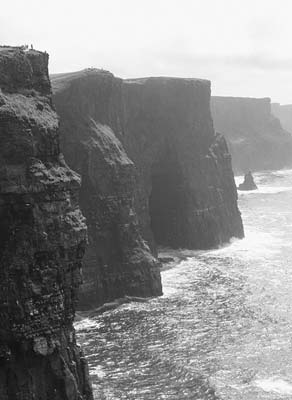
Cost: €6/person, includes parking and admission to the visitors center and its Atlantic Edge exhibit (buy tickets online for a 10 percent discount). It costs €2 to climb O’Brien’s Tower.
Hours: Daily May-Sept 9:00-19:30, gradually later closing times toward mid-summer—as late as 21:00 July-Aug; Oct-April 9:00-17:00.
Information: You’ll find a TI and ATM in the visitors center—the Tolkienesque building tucked under the grassy hillside—flanked by six hobbit garages housing gift shops (across the street from the parking lot). Tel. 065/708-6141, www.cliffsofmoher.ie.
For this self-guided tour, start in the visitors center, built in a concentric-circle layout with local stone. Upstairs is the Long Dock restaurant (which serves coffee and substantial cafeteria-style meals until 19:00); a photo diorama showing aerial views of the cliffs and underwater photos of local marine life; and the toilets, where you can enjoy a huge panoramic photo of the cliffs on the stall doors as you wait in line. Downstairs is a small café, a gift shop, and the Atlantic Edge exhibit.
The Atlantic Edge exhibit focuses mainly on natural and geological history, native bird and marine life, and virtual interactive exhibits aimed at children (often occupied by adults). You may even learn why the cliffs are always windy. A small theater with an IMAX-style screen shows The Ledge, a film following a gannet who’s a Jonathan Livingston Seagull wannabe, as he flies along the cliffs and then dives underwater, encountering puffins, seals, and even a humpback whale along the way.
After leaving the visitors center, walk 200 yards to the cliff edge and along the wall of the local Liscannor slate. Notice the squiggles made by worms, eels, and snails long ago when the slate was still mud on the seafloor.
For years, the Irish didn’t believe in safety fences: just natural selection. Anyone could walk right up to the cliffs, until numerous fatal accidents prompted the hiring of “rangers”—ostensibly there to answer your questions and lead guided tours, but mainly there to keep you from getting too close to the edge (wind gusts can be sudden, strong, and deadly).
As you gaze down at the waves crashing far, far below you, consider this: Surfing in wet suits is becoming popular in Ireland. Most sane Irish surfers stick to the predictable waves at Lahinch (5 miles south of here). But the monster waves that rear up beneath the Cliffs of Moher on stormy days are coveted by extreme surfers, who work in tandem with tow/rescue helpers skimming the waves on Jet Skis. Don’t strain your eyes looking for them...there aren’t too many surfers crazy enough to attempt this.
O’Brien’s Tower, built in 1835, marks the highest point of the cliffs (but isn’t worth the fee to climb...30 feet up doesn’t improve the views much). Hike five minutes up to the tower and look to the north (your right). In the distance, on windy days, you can see the Aran Islands wearing their white necklace of surf.
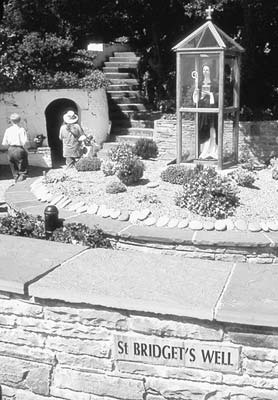
Nearby: Before leaving the area, drivers can take 10 minutes to check out the Holy Well of St. Bridget, located beside the tall column about a half-mile (1 km) south of the cliffs on the main road to Liscannor. In the short hall leading into the hillside spring, you’ll find a treasure of personal and religious memorabilia left behind by devoted visitors seeking cures and blessings. A trickle of water springs from the hillside at the far end. The simple gray column outside was a folly erected over 150 years ago by a local landlord with money and ego to burn.
To get a different perspective of the cliffs (looking up instead of down), you can cruise along their base. Try for an afternoon cruise, when the sun is coming from the west, illuminating the detail on the dramatic cliffs. Two companies—Doolin2Aran Ferries (tel. 065/707-5949, mobile 087/245-3239, www.doolin2aranferries.com) and O’Brien Line (tel. 065/707-5555, www.obrienline.com)—offer almost identical cruise options. Both make the one-hour voyage past sea stacks and crag-perching birds. Boats depart from the pier in Doolin (same dock as Aran Islands boat, €20, runs daily April-Oct, 3/day, weather and tides permitting, call or go online for sailing schedule and to reserve). They also operate day-trip cruises from Doolin to Inisheer (the closest Aran Island—described in the Aran Islands chapter), then along the base of the Cliffs of Moher and back to Doolin (for details, see here).
This town was once a strange phenomenon. Many music lovers would go directly from Paris or Munich to Doolin, which was on the tourist map for its traditional music. A few years ago, this was a mecca for Irish musicians, who came together here to play before a few lucky aficionados. But now the crowds and the foreigners have overwhelmed the musicians, and the quality of music is not as reliable. I prefer Dingle’s richer music scene. Still, as Irish and European fans crowd the pubs, the bodhrán beat goes on.
Doolin has plenty of accommodations and a Greek-island-without-the-sun ambience. The “town” is just a few homes and shops strung out along a valley road from the tiny harbor. Residents generally divide the town into an Upper Village and Lower Village. The Lower Village is the closest thing to a commercial center (meaning it has a couple of pubs and a couple of music CD shops). The Upper Village has a TI at Hotel Doolin that generally exists to book lodging and Aran Islands boat trips (mid-March-Oct daily 9:00-19:00, tel. 065/707-5642).
Doolin Activity Lodge offers a handy grab-bag of services, including recommended accommodations, an Internet café (€3/30 minutes, free to lodgers, daily 8:00-21:00, 4 terminals), and a launderette (drop-off only, pick up clothes in 6 hours, no self-service, same hours as café). The staff can also recommend local horseback riding, hiking, and fishing options.
Doolin is famous for three pubs, all featuring Irish folk music: Nearest the harbor, in the Lower Village, is Gus O’Connor’s Pub (tel. 065/707-4168). A mile farther up the road, the Upper Village—straddling a bridge—is home to two other destination pubs: McGann’s (tel. 065/707-4133) and McDermott’s (tel. 065/707-4328). Music starts in the pubs between 21:30 and 22:00, finishing at about midnight. Get there before 21:00 if you want a place to sit, or pop in later and plan on standing. The craic is fine regardless. Pubs serve decent dinners before the music starts. (Dial-A-Cab is a handy service for folks without wheels wanting to link a night of fun in Doolin with a bed in Lisdoonvarna; mobile 086-812-7049 or 087-290-2060.)
From Doolin, you can hike up the Burren Way along the coast for three miles to the Cliffs of Moher. Local guide and farmer Pat Sweeny operates Doolin Cliff Walk, leading walking tours that depart daily at 10:00 from O’Connor’s Pub. The walk to the cliffs takes three hours; you catch the 13:30 bus back to Doolin (€5, May-Sept, tel. 086/822-9913, www.doolincliffwalk.com, best to phone ahead to reserve and check weather/trail conditions). Doolin also offers boat cruises along the Cliffs of Moher (see here).
$$ Harbour View B&B is a fine modern house with six rooms, overlooking the valley a mile from the Doolin fiddles. Cathy Normoyle keeps the place immaculate, and serves home-baked bread from her mom’s house out back (Sb-€45-55, Db-€60-76, Tb-€75-90, includes fine breakfast, Wi-Fi, on main road halfway between Lisdoonvarna and Cliffs of Moher, next to Aran View Market and gas station, tel. 065/707-4154, www.harbourviewdoolin.com, clarebb@eircom.net).
$$ Doolin Activity Lodge is a modern compound of four stone buildings with 21 bright, airy, good-value rooms (Sb-€35-45, Db-€60-80, Tb-€90-110, Qb-€100-140, located halfway between Upper and Lower Villages, tel. 065/707-4888, mobile 087/223-9638, www.doolinlodge.com, info@doolinlodge.com). The lodge offers handy amenities (details listed earlier).
$$ Half Door B&B is the coziest place around, with six woody rooms and a pleasant sun porch. It’s just a short walk from the best pubs in the Upper Village (Sb-€45-60, Db-€65-80, Tb-€100-105, Qb-€120-130, family room, cash only, Wi-Fi, a keg’s roll from McDermott’s pub, tel. 065/707-5959, www.halfdoordoolin.com, ann@halfdoordoolin.com).
$ Doolin Hostel, right in Doolin’s Lower Village with 60 beds, caters creatively to the needs of backpackers in town for the music. Friendly Anthony and Dierdre are on top of the local scene (dorm bed-€14-18, Db-€49-60, Tb-€64-82, Qb-€59-85, Lower Village, tel. 087/282-0587, www.doolinhostel.ie, anthony@doolinhostel.ie).
Restaurants in this village have a habit of opening and then closing in less than two years (too fly-by-night to list in a guidebook). It’s tough to make a go of it. But try the Ivy Cottage in the Lower Village, just past the bridge, with its pleasant, leafy tea garden out front. They do a dish of the day as well as simple sandwiches, quiche, or chowder (daily 10:00-18:00). Next door, the Sea Salt chipper uses the same kitchen and does reasonable fish-and-chips to take away and enjoy with the coastal view of your choice (daily 12:00-21:00). Doolin’s reputation for pub grub is consistently good. In the Lower Village, try Gus O’Connor’s Pub, and in the Upper Village, give McGann’s a spin. Mac’s Daybreak is the town market (Mon-Sat 8:30-20:00, Sun 9:00-20:00, on R-478 above town next to the Harbour View B&B).
From Doolin by Bus to: Galway (5/day, 1.5-2 hours), Ennis (5/day, 1.5-2.5 hours). Buses depart from the recommended Doolin Hostel.
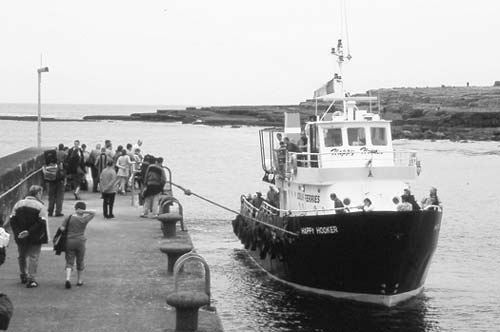
By Ferry to the Aran Islands: For the full rundown on ferries from Doolin, see here. In short, if you want to day-trip from Doolin, go with either Doolin2Aran Ferries (tel. 065/707-5949, mobile 087-245-3239, www.doolin2aranferries.com) or O’Brien Line (tel. 065/707-5555, www.obrienline.com), both of which take you to the closest island, Inisheer (with time to explore), then back along the Cliffs of Moher. If you want to visit either or both of the farther islands—Inishmaan and Inishmore—plan on an overnight stop, due to the transit time involved.
Treated almost like an inland extension of Doolin, this town of 1,000 (4.3 miles/7 km from Doolin) is a bit bigger, with a few more amenities but no coastal charm. It was known for centuries for its spa, its matchmakers, and its traditional folk music festivals. Today, it’s pretty sleepy, except for a few weeks in September, during its Matchmaking Festival (www.matchmakerireland.com), which partially inspired the 1997 film The Matchmaker. The nearest ATMs are in Lahinch or Ennistymon. Still, it’s more of a town than Doolin and, apart from festival time, less touristy.
Sleeping in Lisdoonvarna: $$ Ballinsheen House is the best value in town. It’s perched on a hill with five tastefully decorated rooms and a pleasant, glassed-in breakfast terrace (Sb-€43-55, Db-€66-90, “Superior” Db-€86-110, Tb-€90-118, Wi-Fi, parking, 5-minute walk north of town on N-67 Galway Road, tel. 065/707-4806, mobile 087-124-1872, www.ballinsheen.com, ballinsheenhouse@hotmail.com, Mary Gardiner).
Eating in Lisdoonvarna: The Roadside Tavern is a favorite local hangout with filling pub grub, great atmosphere, and occasional traditional-music sessions (daily, tel. 065/707-4084, on N-67 in town tucked down behind the Spa Hotel in hard-to-miss bright red).
Literally the “rocky place,” the Burren is just that. This 10-square-mile limestone plateau, a ▲▲ sight, is so barren that a disappointed Cromwellian surveyor of the 1650s described it as “a savage land, yielding neither water enough to drown a man, nor a tree to hang him, nor soil enough to bury him.” But he wasn’t much of a botanist, because the Burren is in fact a unique ecosystem, with flora that has managed to adapt since the last Ice Age, 10,000 years ago. It’s also rich in prehistoric and early Christian sites. This limestone land is littered with hundreds of historic stone structures, including dozens of Iron Age stone forts. When the first human inhabitants of the Burren came about 6,000 years ago, they cut down its trees with shortsighted slash-and-burn methods, which accelerated erosion of the topsoil (already scoured to a thin layer by glaciers)—making those ancient people partially responsible for the stark landscape we see today.
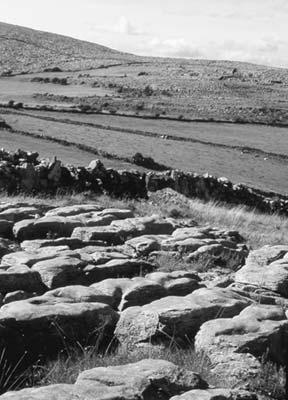
(See “The Burren” map, here.)
This self-guided drive from Kilfenora to Ballyvaughan offers the best quick swing through the historic Burren.
• Begin in the town of Kilfenora, eight kilometers (5 miles) southeast of Lisdoonvarna, at the T-intersection where R-476 meets R-481.
This town’s hardworking, community-run Burren Centre shows an informative 10-minute video explaining the geology and botany of the region, and then ushers you into its enlightening museum exhibits (€6, daily June-Aug 9:30-17:30, mid-March-May and Sept-Oct 10:00-17:00, closed Nov-mid-March, tel. 065/708-8030, www.theburrencentre.ie). You’ll also see copies of a fine eighth-century golden collar and ninth-century silver brooch (now in Dublin’s National Museum).
The ruined church next door has a couple of 12th-century crosses, but isn’t much to see. Mass is still held in the church, which claims the pope as its bishop. As the smallest and poorest diocese in Ireland, Kilfenora was almost unable to function after the Great Potato Famine, so in 1866 Pope Pius IX supported the town as best he could—by personally declaring himself its bishop.
For lunch in Kilfenora, consider the cheap and cheery Burren Centre Tea Room (daily 9:30-17:30, located at far back of building) or the more atmospheric Vaughan’s Pub. If you’re spending the night in County Clare, make a real effort to join the locals at the fun set-dancing get-togethers run by the Vaughans in the Barn Pub, adjacent to their regular pub. This local dance scene is a memorable treat (€5, Sun at 21:30, mid-May-mid-Sept also Thu at 21:30, call ahead to confirm schedule, tel. 065/708-8004).
• To continue from Kilfenora into the heart of the Burren, head east out of town on R-476. After about five kilometers (3 miles), you’ll come to the junction with northbound R-480. Take the sharp left turn onto R-480, and slow down to gaze up (on the left) at the ruins of...
This ruined shell of a fortified house is not open to anyone these days. From the outside, you can see how the 15th-century fortified tower house (the right quarter of the remaining ruin) was expanded 150 years later (the left three-quarters of the ruin). The castle evolved from a refuge into a manor, and windows were widened to allow for better views as defense became less of a priority.
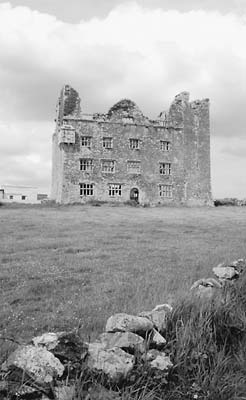
• From the castle, turn north on R-480 (direction: Ballyvaughan). After about eight kilometers (5 miles), you’ll hit the start of the real barren Burren. Keep an eye out for the next stop.
One of many ring forts in the area, you can see the low stone profile of Caherconnell to the left on the crest of a hill just off the road. You can park in the gravel lot and walk up to the small visitors center and handy café for an informative 20-minute film followed by a quick wander through the small fort. The fort sometimes features a sheepherding demo with dogs (generally at 12:00 and 15:00—call to confirm).
Cost and Hours: €7, €9.50 includes sheepherding demo, daily July-Aug 10:00-18:00, Easter-June and Sept-Oct 10:00-17:00, closed Nov-Easter, tel. 065/708-9999, www.burrenforts.ie.
• The stretch from the ring fort north to Ballyvaughan offers the starkest scenery. Soon you’ll see a 10-foot-high stone structure a hundred yards off the road to the right (east, toward an ugly gray metal barn). Pull over for a closer look.
While it looks like a stone table, this is a portal tomb. Two hundred years ago, locals called this a “druids’ altar.” Five thousand years ago, it was a grave chamber in a cairn of stacked stones. Amble over for a look. (It’s crowded with tour buses at midday, but it’s all yours early or late.)
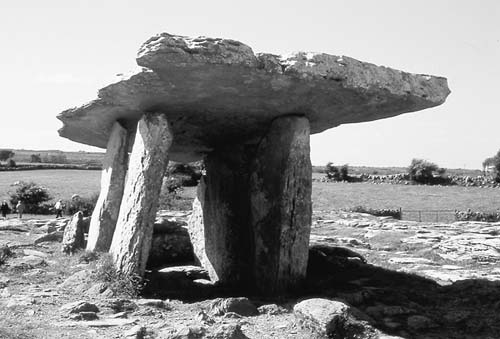
Wander about for some quiet time with the wildflowers and try to think like a geologist. You’re walking across a former seabed, dating from 250 million years ago when Ireland was at the equator (before continental drift nudged it north). Look for white smudges of fossils. Stones embedded in the belly of an advancing glacier ground the scratches you see in the rocks. The rounded boulders came south from Connemara, carried on a giant conveyor belt of ice, then left behind when the melting glaciers retreated north.
• As you drive away from the dolmen (continuing north), look for the 30-foot-deep sinkhole beside the road on the right (a collapsed cave). From here, R-480 winds slowly downhill for about six kilometers (4 miles), eventually leaving the rocky landscape behind and entering a comparatively lush green valley. A little before Ballyvaughan, you’ll see a sign pointing up a road to your right to...
As these are touted as “Ireland’s premier show caves,” I couldn’t resist a look. While fairly touristy and not worth the time or money if you’ve seen a lot of caves, they offer your easiest look at the massive system of caves that underlie the Burren. Your guide walks you 300 yards into the plain but impressive cave, giving a serious 40-minute geology lesson. During the Ice Age, underground rivers carved countless caves such as this one. Brown bears, which became extinct in Ireland a thousand years ago, found them great for hibernating. If you take the tour, you’ll need a sweater: The caves are a constant 50°F.
Cost and Hours: Caves-€12, bird center-€10, €18 combo-ticket includes both sights but not Hawk Walk; open daily at 10:00, last tour at 18:30 July-Aug, otherwise 17:30, Dec-Feb call ahead for limited tours; clearly signposted just south of Ballyvaughan, tel. 065/707-7036, www.aillweecave.ie.
Nearby: Just below the caves (and on the same property) is the Burren Birds of Prey Centre, with caged owls, eagles, hawks, and falcons (bird demonstrations likely at 12:00, 14:00, and 16:00—but call for daily schedule).
Adjacent to the caves, the Hawk Walk gets visitors face-to-beak with a Harris hawk, “the world’s only social raptor.” After a brief training session, an instructor leads a small group on a 45-minute hike up a nearby mountain trail. Those paying the stiff €70 fee get to launch and call back the bird to perch on their arm (limited slots, must reserve).
• Continuing on, our final destination is...
This tiny town, between Ballyvaughan and Galway (30 minutes from each), is waiting for something to happen in its minuscule harbor. It faces Dunguaire Castle, a four-story tower house from 1520 that stands a few yards out in the bay.
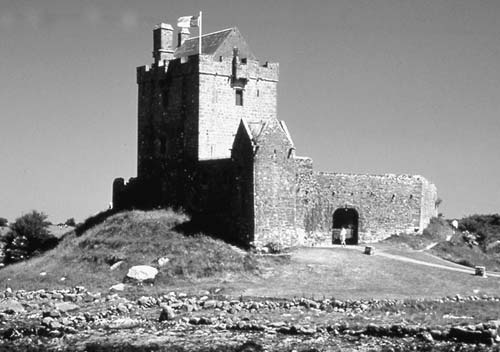
The touristy but fun Dunguaire Castle medieval banquet is Kinvarra’s most worthy attraction (€50, cheaper if you book online, mid-April-mid-Oct Fri-Tue at 17:30 and sometimes at 20:45, closed Wed-Thu and mid-Oct-mid-April, reservations tel. 061/360-788, castle tel. 091/637-108, www.shannonheritage.com). Warning: The company also operates banquets at Bunratty Castle (30 miles south), so be sure that you make your reservation for the correct castle.
The evening is as intimate as 55 tourists gathered under one time-stained, barrel-vaulted ceiling can be. You get a decent four-course meal with wine (or mead if you ask sweetly), served amid an entertaining evening of Irish tales and folk songs. Remember that in medieval times, it was considered polite to flirt with wenches. It’s a small and multitalented cast: one harpist and three singer/actors who serve the “lords and ladies” between tunes. The highlight is the 40-minute stage show, which features songs and poems by local writers, and comes with dessert.
You can visit the castle itself by day without taking in an evening banquet (€6, daily 10:00-16:30).
Sleeping in Kinvarra: $$ Cois Cuain B&B is a small but stately house with a garden, overlooking the square and harbor of the most charming village setting you’ll find. Mary Walsh rents three super-homey rooms for non-smokers (Db-€60-75, cash only, Wi-Fi, The Quay, tel. 091/637-119).